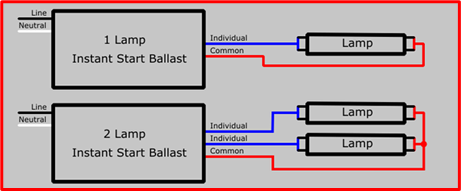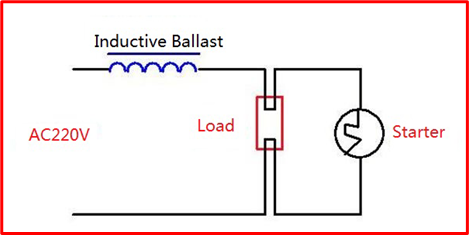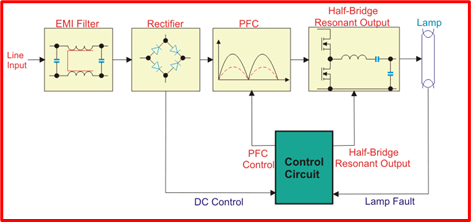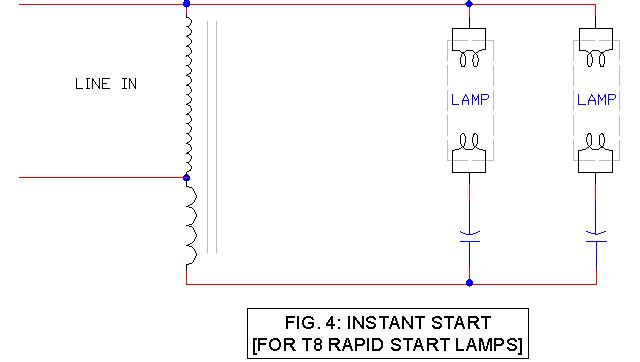Fluorescent Ballasts
The ballast is a device that limits the amount of current flowing through the fluorescent bulb and produces an instantaneous high voltage.
It is created by encircling a silicon steel iron core with enameled wire.
The electrodes (filament) at the ends of the fluorescent tube are added to the high voltage produced by the coil’s instantaneous on/off and on/power operations with an iron core.
In a fluorescent lighting system, the ballast controls the current to the bulbs and supplies enough voltage to turn them on. A fluorescent light connected directly to a high-voltage power source would rapidly and uncontrollably increase its current consumption if there wasn’t a ballast to control it.

Types Of Fluorescent Ballasts
- Magnetic Ballast
- Electronic Ballast
- Magnetic Leakage Ballast
- Instant Start Electronic Ballast
- Trigger Start Ballast
- Program Start Electronic Ballast
How They Work
- Magnetic Ballast
Magnetic ballast, also referred to as inductive ballast, is an inductance coil with an iron core. Due to the inductance’s nature, as the coil’s current changes, the magnetic flux also changes, producing an induced electromotive force. Hence, the existing changes are hindered.

Electric current flows through the ballast to the starter, lamp filament, and filament heating. When the switch is closed to 220V, 50Hz AC power (at the beginning of the starter is broken, due to a greater than 180V AC voltage, the starter has jumped the gas inside the bubble glow discharge, jump bimetallic strip is heated inside the bubble expansion deformation, two electrodes together, forming pathways to the filament heating).
The bimetallic sheet cools and the two electrodes of the starter get detached when they are close together since there is no arc discharge. The current in the circuit abruptly disappears when the two electrodes are disconnected because of the inductance of the inductive ballast.
To ionize the inert gas in the lamp tube and create an arc discharge, the ballast produces a high pulse voltage that is added to both ends of the lamp tube superimposed with the power supply voltage. (High pulse voltage time is around 1 ms and ranges from 600 to 1500 volts; actual voltage value depends on lamp type.)
The self-inductance of the ballast works to maintain the circuit’s current during typical lighting operations.
- Electronic Ballast
An electronic device that drives an electric light source to generate the necessary lighting is referred to as an electrical ballast. The power grid’s energy is converted by the electrical components to provide the matching bulbs with the voltage and current they need.

After going through a full-wave rectification, a passive (or active) power factor corrector, and an RFI filter, the power frequency power supply is transformed into a DC power supply (PPFC or APFC). A resonant high voltage is generated on the capacitor and applied to both ends of the lamp tube at the same time that a high-frequency AC power (of 20 kHz to 100 kHz) is output through the DC/AC converter to heat the filament of the lamp.
The lamp tube’s “discharge,” though, is switched to the “on” state and then moves into the light-emitting state. The high-frequency inductance is now able to regulate the current’s growth and guarantee that the lamp tube receives the lamp voltage and lamp current necessary for normal operation.
- Magnetic Leakage Ballast
To produce a greater open-circuit voltage and a longer-lasting lamp operating current, the fundamental wave is modified by auto-coupling boost and local magnetic saturation. This type of high power factor lighting circuit, whose line power factor is between 0.90 and 0.97, provides special benefits for point HID light sources.
- Instant Start Electronic Ballast
It utilizes a high starting voltage (about 600 volts) to ignite something quickly (less than 0.1 seconds).

Although they are best suited for a small amount of switching, the electrodes do not need to be preheated for the optimum energy efficiency (10,000 to 15,000 switch cycles before failure). In parallel, wiring is instant start ballasts.
- Trigger Start Ballast
It applies the starting voltage (about 500 volts) while heating the electrodes to start the lamps swiftly within 0.5 to 1.0 seconds. While the lamps are on, the electrodes continue to heat up, using a bit more energy than immediate start ballasts (about 2 watts per light). Before failing, they can perform 15,000 to 20,000 switch cycles. Ballasts for quick starts are wired in series.
- Program Start Electronic Ballast
They begin within one to five seconds. Before supplying the starting voltage, they provide the electrodes a regulated preheating. Ballasts with a programmed start reduce electrode stress and extend bulb life for frequent starting (areas with occupancy sensors). Before breaking down, they can perform 50,000 switch cycles. The wiring of programmed start ballasts is in series.
PDFs / Technicals
Control Circuits for Ballast Design
(Video) Overview
Useful Resources
Continued Learning:
Electrical Resistance: How It Works
Contactors vs Relays: How Do They Work?
Brake Rectifiers and Reactors Explained
Brake Choppers: A Detailed Overview
Three Phase Power Explained: What is 3 Phase?
FAQ
What does a fluorescent ballast do?
A fluorescent ballast is a device that regulates the flow of electrical current to a fluorescent light bulb. It provides the necessary voltage and current to start the bulb and maintain its operation at a consistent level.
What are the types of fluorescent ballasts?
There are two main types of fluorescent ballasts: magnetic ballasts and electronic ballasts. Magnetic ballasts are older and less efficient, while electronic ballasts are newer and more energy-efficient.
How do I know if a ballast is bad?
There are several signs that a fluorescent ballast may be bad. These include flickering or dimming lights, a buzzing or humming sound, and the bulb taking longer than usual to light up or not lighting up at all.
What happens when a ballast goes bad?
When a ballast goes bad, it can cause several problems, including the bulb not lighting up, flickering or dimming lights, or a buzzing or humming sound. It can also cause the bulb to burn out prematurely.
How often do fluorescent ballasts need to be replaced?
The lifespan of a fluorescent ballast can vary depending on usage and other factors, but on average, they last around 10 to 15 years. It is recommended to replace the ballast when it starts showing signs of wear and tear or when the bulb is replaced.